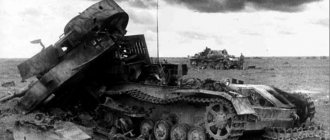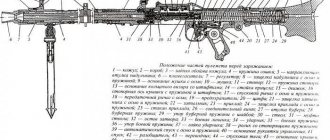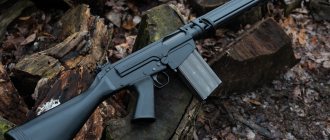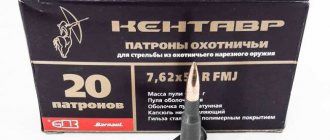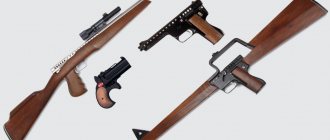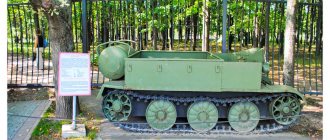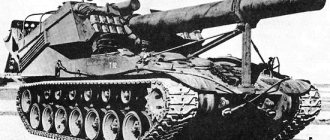Guess the riddle:
There lived a rich gentleman. One morning he had to leave on a trip. But before he left, the watchman ran up to him and started shouting that the master should not go anywhere, because he dreamed that the master would get into an accident. But the master took him and fired him. For what? Show answer>>
There lived a man. He came to work and slept there every night. He turned on the light and forgot that night. In the morning he looked out the window and hanged himself. What was his job and why did he hang himself? Show answer>>
I lived in the middle of the yard, where children play, but from the sun's rays I turned into a stream. Show answer>>
Other meanings of this word:
- a “hammer” that breaks the piston or primer when firing; striking part of the mechanism in a firearm
- "Start button" of the pistol
- Pistol and rifle "start button"
- Weapon mechanism detail
- revolver detail
- Firearm part, part of the firing mechanism
- hook that's on edge
- "Skirmisher" hook on a pistol
- If you press it, it will shoot
- press it and it will shoot
- The name of which part of the weapon came to us through the Polish language (the Poles translated the German word “rooster” meaning this part)
- the name of which part of the weapon came to us through the Polish language (the Poles translated the German word “rooster” meaning this part)?
- An integral element of wick, wheel and impact flintlocks, on which the wick, pyrite or flint is attached
- An integral element of matchlocks, wheel locks and impact flintlocks, on which the wick, pyrite or flint is attached.
- Fire starter
- it cocks before firing
- He's cocking the pistol
- They must go to the mill // Arrive tomorrow before dawn, // Turn on each other... // And aim at the thigh or temple. (A. Pushkin, “Eugene Onegin”)
- intermediary between finger and gun
- rifle, trigger
- cocking lever
- Release the sawn-off shotgun
- Revolver release
- Triggering the gun
- Pistol trigger
- They come down to shoot
- Trigger detail
- Trigger (unfolded)
- Weapon trigger
- pistol trigger
- Impact mechanism in a rifle
- Part of the firing mechanism in a firearm
- Part of the firing mechanism in a handgun
- what does the sniper drop?
- What does the sniper shoot?
weapon
— O. are called tools made by man to fight his enemies, people or animals. The method of using O. determines the different types of O.: percussion, piercing, chopping, throwing. Its improvement forced the invention of objects that protected a person from enemy blows: or O. . The further development of weapons created tools whose operation required the combined efforts of several people. Thus, O. were divided into groups: 1) O., which can be operated by one person, and its weight and design are such that it can be carried with oneself - manual and 2) O., in weight and design, requiring the combined action of several persons, and sometimes special devices - military vehicles or weapons or artillery pieces. The invention of gunpowder divided all weapons into two groups: firearms and cold or white weapons. The first group, divided into hand-held fire weapons and artillery weapons or artillery , includes all weapons that require gunpowder or other explosives to operate, and the defeat is not caused directly by the weapon, but by a special projectile ejected from the weapon, the force formed when burning explosive gases. For the design data of hand weapons, see Magazine Weapons, Shotguns and Melee Weapons.
Story. For information about weapons in ancient times, see Stone Age and Stone Tools. We have only insufficient information about the Chaldean and Assyrian O., gleaned from images, the antiquity of which does not go back further than 1500 years BC. The Assyrians and Babylonians were armed with pointed helmets, short swords, probably daggers, axes or battle axes, as well as round shields, bows and spears. It seems that some of the warriors wore scaly armor. The main source of information about Egyptian architecture are images on tombs; it consisted of axes, daggers, knives, khopesh (a type of broadsword), spears, darts and bows. To protect the left hand from the blow caused by a lowered bowstring, the Egyptians wore flat hoops or bracelets. Helmets and armor were in general use. It seems that the Egyptians also knew the boomerang. Among the Greeks, the most ancient weapons were made of stone: pointed, or with a sharpened blade and axes and hammers were made from hard stones. Knives and tips were made from obsidian, since flint is rarely found in Greece. Schliemann's excavations introduced the production of bronze objects at a time when stone ones had not yet fallen out of use. Mycenaean swords amaze with their luxury. One corpse from Mycenaean graves wore a cuirass made of solid gold. Although the Greeks were not slow to use iron for their offensive weapons, they continued to wear helmets, shields, cuirasses and leggings made of bronze. Peltasts had two darts, up to 1 1/2 m long, with a sharp piece of iron. The mercenaries threw slings and fired arrows. sword was straight and double-edged. The spear had a wide, long and sharp tip, in the shape of a laurel leaf, sage, etc. The hoplites, built in battle formation, had a wall of spears in front of them and, being covered with shields, helmets and leggings, could easily do without armor, why is this part of the weapon they often lack it. The light infantry's weapons consisted of a sword, a small shield and a javelin; there were no greaves. A mounted warrior was better protected than a foot warrior; his greaves were higher; he sometimes wore heel guards, knee pads made of bronze, and leg guards on his hips; the armament of the mounted warrior consisted of a sword, a spear, a reed and a bronze club.
The Romans received their first O. from the Etruscans. The Romans' shields the round shield (clipens), the large shield (scutum) and the small round shields (parma and caetra). Before the Second Punic War, the Romans had pretty bad swords; later they introduced the Iberian sword and learned to manufacture it. The typical weapon of senior commanders and generals was a wide dagger or short belt sword - parazonium. The Romans used spears and pilums with shafts.
Middle Ages. The most ancient German legends feature the iron hammer of the thunderer Thor; the appearance of the sword is a significant success of civilization. By the end of the 5th century, the armor of the Germans consisted of a long sword, a short sword, a knife, a battle ax (berdish or francisca), a small angon, a javelin or frame, and a large shield. Long swords are rare; Only bosses wear them. The most commonly used weapon was a short sword - skramasax. Before the clash with the Romans, the Germans only had knives (sax, sahs, seax), which were used at home and in hunting, and then in war. Lengthening the knife created a skramasax with a long handle, for both hands. Franziska or berdysh is a battle ax whose blade forms curved bends. Frameya is a short spear (dart), together with the shaft, not exceeding human height. Angon is a slightly modified Roman pilum. The shields used were large, made of willow wicker, covered with leather. With the advent of knighthood, the long sword became the main weapon of the equestrian warrior; at the same time, the meaning of the spear increases. The Crusades showed the West. the cavalry has imperfect weapons; she saw in front of her a mobile, hardy cavalry, armed with a spear, a club, an ax and a bow, and the infantrymen had a crossbow, the cannonballs of which even pierced the shell. Archery units were formed in England and Brabant. Europeans adopted a curved sword, a light spear - pennon, and improved types of bows and crossbows from the eastern peoples. O., like armor, increased in weight; the shaft of the spear began to become thicker, the sword - heavier; the spear, previously controlled by a freely raised hand, now had to be rested against the notch of the shoulder pad to strike. This direction, which excluded the possibility of a closed formation, continued until the 13th century. The development of infantry forced knighthood to fight in groups (small squadrons); As a result, the weapons become lighter and the mounted warrior gains greater freedom of action. Crossbow and bow are found in greater numbers. Around 1330, two types of shields appeared: one, used by knights (round), was worn on a long belt on the left hand; the other, which served for infantry, was larger (up to 1 meter), made of wood, fastened at the edges and crosswise in the middle with iron strips. This shield was strengthened in battle with its sharp end into the ground. Since the 14th century two swords of different sizes are often worn; the smaller one does not exceed one meter in length, and the larger one, often used in foot combat, was two-handed. A wide variety of forms were represented by short knives and daggers (dags). In addition, a battle ax was used, with a point at the top so that injections could be made. The mounted warriors chopped with both hands, rising in the stirrups and sitting on the pommel of the saddle. For infantrymen, axes were mounted on a long shaft and were equally suitable for stabbing, chopping and even pulling off the saddle; These axes were called guisarmes, faucharts, godendacs. The knights also had clubs made of wood, which were filled with nails and iron points. The battle whip (flé au d'armes) is a club with a movable head connected to the shaft by means of a leash or chain. More often than others, it is found among eastern peoples, the Byzantines, Germans and Swiss, in the 14th and especially in the 15th centuries. The spear is very long; its shaft, usually made of ash, ended in a short, convex pointed piece of iron, in the shape of a leaf, a pyramid or an awl. The crossbow was in great use among infantrymen; shooting from it required more time than archery, but the blow was more accurate and hit farther. It disappears only in the 16th century, when gunshot O. appears; The crossbow was very little inferior to the first hand-held arquebuses. As the importance of infantry increases, so does attention to its weapons. Until the XIV table. it consisted of a heavy shield and a spear; then, leaving the shield, they began to use a short sword and a short dagger. Some infantrymen, distinguished by their strength, fought with huge swords and heavy clubs. Everywhere spears, short swords, swords, crossbows imitate the Italian O in their form. European influence also affects the Turkish weapons. troops. The Janissaries were armed with a bow and a curved sword, and the Spagi or Timariotes (consisting of Europeans) fought with a long straight sword and a spear on a thin shaft; the inhabitants of Anatolia were armed in a completely Asian way - with a curved sword, a bow, an ax and a dart (djerid). From the XIV table. crossbow shooters were forced to increase their means of self-defense: for this purpose, a large, human-sized, wooden shield covered with leather - pavois (Setzschild) - was introduced. Almost simultaneously, several smaller shields, quadrangular in shape, appeared: hand shields (petit pavois, handtartsche) and chest tarchs (Brusttartsche), brought to Hungary from B, and a fist shield or boce (Faustschild, boce, rondelle de poing), which lasted until the end of the 16th century. table. The archers were light infantry; they were skirmishers and the first to start the battle. From the percussion O. to the XV table. used: war hammer (marteau d'armes) - originally a simple blacksmith's hammer with a long handle, made of horn or hard wood; then they began to sharpen the end of the hammer, and continued the handle at the point to inflict injections. The end of the hammer was very often shaped like a bird's beak (a bec). Small hammerheads (picois) are characterized by a sharp, barely curved beak; they were used until the 17th century. Plommea (plomm é e) - a large hammer and together a combat whip (flail), with a long handle to which iron balls were attached; used mainly in Germany and Bohemia; among the Swiss, its head was equipped with a star-shaped point. The club, originally made from strong wood, began to be made of steel and iron, and the head was covered with standing ribs; This kind of club was called pernacha.
XVI century. At the end of the 15th century, with the introduction of a standing army, weapons took on a more homogeneous character. A new element is introduced into the cavalry - the gendarmes; in Germany, representatives of heavy cavalry are cuirassiers. The armor of the heavy cavalry consisted of a spear and a sword; in addition, the officers were armed with elegant hammers. The light cavalry weapon consisted of a sword, carbine and arquebus. Most of the infantry were armed with firearms, but there were also pikemen with pikes or halberds. The Swiss were armed with long spears, a short sword and a dagger, and some also with heavy axes. Initially, a significant part of this army fought with swords of monstrous sizes. The landsknecht weapon (q.v.) consisted of a long spear, a sword and a short dagger. Some, imitating the Swiss, fought with a two-handed sword (“Bidenhander”). The shooters consumed hand culverin. At the end of the 16th century. the arquebus is reduced to a carbine, which is made double-barreled and often has a revolver design; the culverin gives way to the musket. The armament of the Poles was dominated by a mixture of eastern. and zap. samples. The higher nobility was armed according to the German model and had a spear and a sword; the lower gentry formed detachments of light cavalry and, being protected by chain mail armor, were called. shellfish; The Cossacks were armed with a saber and a bow. The Hungarians also had similar weapons. Throughout the entire first half of the 16th century. German infantrymen used long, thin swords. Such swords were only suitable for thrusting, which is why it is more correct to call them swords; The primitive Scottish broadsword, the claymore, also belongs to the same type. During the reign of Elizabeth, the Italian broadsword (schiavone), with a guard in the form of a basket or cradle, began to spread in England. At this time, swords with a narrow (faceted) blade - rapiers - also appeared. The shield decreases in size; The boce or fist shield is becoming widespread. In rapiers or brettes, the guard completely covers the hand; they were always used together with weapons for the left hand (usually the daga). The rapiers were very long (almost 1.5 m). Swords of justice - swords for two hands, with a blade truncated at the end at a right angle - came into use during executions quite late. Their blades are engraved with the coats of arms of cities, sovereigns, mottos and emblems. Never has O. for the left hand enjoyed such fame as in the 16th century. His blade often features a special device in which, as soon as the thumb presses the spring button, the blade splits into three parts. The name stilettos meant small daggers worn in boots, in sleeves or under a jacket. Soldiers stopped using the dagger around the middle of the 17th century; At the same time, the O. of the left hand went out of use, although among the Spaniards and Italians it was found much later. For cavalry, the main weapon remains the spear, equipped with a shield for protection and a counterweight at the end. The gendarme's large spear required very strong and experienced warriors, riding tall war horses, the prices of which were rising ever higher. In view of this, in 1605, Henry IV issued a decree prohibiting the use of the spear. From O., the infantry with the polearm retain the pike; only the Swiss retain the halberd until the end of the 16th century. Protozan and corseca are worn only in parades; mowers and siege knives are used during sieges and attacks. Junior infantry officers are armed with a half-pike - an esponton. Artillery officers have a coat (porte m è che). Battle axes (axes) were not used later than the second half of the 16th century, turning into crickets (criquet) - a mixed weapon, the handle of which forms a pistol. The war hammer did not go out of use until the end of the 16th century; in Austria, in the Turkish wars, it continued to be used in the 17th century, and in Asia, among the eastern peoples - even now, together with the ax and mace. Protosans XVI century. are distinguished by luxurious finishes. At the beginning of the 16th century. The ronsard or spear is mentioned for the first time. Maces, shestopers and pernachs in the 16th century. lose the meaning of a combat O., while remaining an honorary O. The use of onions almost ceases in Europe from the middle of the 16th century; only Landsknechts and English marksmen use it later (the latter - back in 1627). Crossbows also lose all meaning in the 16th century, due to the development of firearms. Handgun O. appears for the first time around 1425, in the form of a short (up to 2 ft.) iron tube, with a long, about a meter, tail that rests on the ground when fired. This O. - a hand-held culverin - was extremely imperfect: a crossbow was always preferred to it. Towards the end of the 15th table. the culverin is made longer; when firing, its muzzle rested on the stand. The arquebus originated from a hand-held culverin and, starting from the 16th century, became the predominant O. When the arquebus player wanted to shoot, he passed the end of the lit wick into the trigger enough to reach the primer, then fanned the fire and opened the shelf. The muskets were very heavy: when firing, they had to be placed on pitchforks stuck into the ground; such a support was called fourquine. Arquebusmen and musketeers carried with them a rather complex device, consisting of a powder flask, a bag of bullets, a small powder flask with powder pulp and many cases, each of which contained a full, pre-prepared charge. Around 1572, these devices were replaced by a wide belt, which was used until the 17th century. A bag of bullets is attached to the belt. The powder flask is hung with a hook. This entire device (fourniment en bandouli è re) was worn on the left side, on top of the sword . The pistol is not found earlier than the second half of the XVI century.
XVII century. Around the middle of the century, complete defensive armament disappears. Copper helmets and a hallecret appear - a collar with which the shoulder pads are connected and the forearms are covered. In the trenches, the rondache has been used for a long time, forming a kind of bracer. O. with a shaft include the protozan, lance, esponton, halberd and reed. A baguette or bayonet is attached to a musket ca. 1640; in general in the 17th century. A combination of fire O. and cold O. is often found. Firearms O. did not make much progress. The use of a flint trigger came into general use only from the second half of the 17th century; at the beginning of the next century the flintlock gun replaced the musket. At the same time, a short musket appeared, a blunderbuss, called a tromblon if the barrel of its barrel expanded in the form of a funnel.
XVIII and XIX centuries. The success of firearms O. little by little gives white (cold) O. only secondary importance; the main O. it remains only with the cavalry. Swords, sabers, broadswords, cutlasses and dirks, pikes and spears remain in use , and in the meaning of honorary O. - protozan, esponton and halberd. The last three varieties at the beginning of the 19th century. are falling out of use everywhere. Flintlock ammunition (guns, carbines and pistols) remained in use until the 40s of this century, when the invention of the percussion cap introduced the percussion or percussion ammunition. The projectile - a lead ball bullet - was driven from the barrel of the weapon, into which gunpowder had previously been poured. The imperfection of shooting with such a device prompted us to make rifling in the O. channel, so that when fired, the bullet would crash into them and receive a certain rotation, reducing the influence of the wind; Thus, in contrast to smooth-walled or smooth, O. rifled appeared. Initially these were rifles, then rifles (see). Already in the 1830s, attempts were made to improve loading, for which a chamber was made at the end of the barrel (Delvigne system), which was soon replaced by a rod (Thouvenin system). Both of these systems did not achieve their goal. The improvement of the bolt and the invention of the unitary cartridge made it possible to introduce an O., loaded from the treasury. Initially it was a Dreyse needle gun (1840), but it did not last long and was replaced by rifles with folding or sliding bolts (in the 50s). Until the second half of the present table. The caliber of guns was usually 14-18 mm; the desire to increase the number of cartridges, as well as reduce the weight of the weapon, forced the caliber to be reduced to 14-10 mm; thus, a small-caliber rapid-fire weapon was born. A further improvement was the magazine or repeat weapon (see Magazine Weapon).
WEAPON.
Russian weapons before the beginning of the 18th century. (for armor, helmets and shields, see under these words). 1. Helmet. 2. Erichonka. 3. Shell. 4. Shield. 5. Sword. 6. Knife. 7. Spears. 8. Flail. 9 and 10. Berdysh. 11. Rohatina. 12. Owl. 13. Timber. 14. Crossbow. 15. Saber. 16. Mace. 17. Pernach. 18. Shestoper. 19. Broadsword. 20. Konchar. 21. Cleaver. 22 and 23. Protosans. 24. Halberd. 25 and 26. Self-made handles. 27. Carbine. 28. Pistol. 29. Pike with an axe. 30. Minting. 31. Armament of foreign troops in the royal service (late 17th century).
History of O. in Russia. The most ancient (Norman) armor - ringed armor, straight swords, long shields, helmets, spears, axes, knives - in the 13th century. is replaced by the Mongol-Tatar - a saber, a round shield, a mass of armor and headpieces that are purely oriental. From the beginning of the 16th century. little by little, the eastern influence begins to weaken, being replaced by the western: solid armor appears, worn, however, only by noble and wealthy persons, as well as royalty. Berdysh were used only by foot soldiers; subsequently they became a characteristic O. Streltsov. Horse warriors used a short ax instead of a reed. The latter is also similar to the toporok or balta. was in general use . In addition to the weapon used in battle, there was also an honorary weapon (formed from the gradually lighter shock weapon): maces, poles, bridles, beams and coins. In the XVII century. four more types of cold weapons appear: broadsword, sword, halberd and protazan; the last two are honorary O. Throwing O. consisted of bows with arrows and other accessories. The first news of the use of firearms dates back to 1382, during the siege of Moscow by Tokhtamysh, when the besieged fired crossbows, gunpowder, mattresses and cannons (mattress in Turkish is a gun). For hand-held firearms there was a common name arquebus; so called, however, artillery. guns. Hand squeaks or hand grips were worn behind the back of the warrior and are called. curtained , in contrast to the curtained ones, which belonged to the artillery. Hand grips were sometimes called self-propelled guns. There were also undersized or short squeaks, screw ones - probably rifled, triple ones - with three barrels, inverted double ones - double-barreled and others. At the end of the 16th or beginning of the 17th century. carbines and pistols came into use . At the same time, handguns and pistols with axes appeared. In the 17th century. muskets appeared that differed from the matchlock only in the length of the barrel, a larger caliber and the use of a cushion when shooting, berendeyka over the left shoulder charges attached to it under roofs (covers) hollowed out of wood and covered with leather. The berendeyka also had a matchlock bag, a bullet bag and a horn for gunpowder or, instead, powder; sometimes the wick was wound around the belt of the berendeika. Established by Peter Vel. The regular army required new types and uniformity in the structure, properties and type of equipment. The Cold O. adopted the same as in the Western troops, differing little from it in appearance (see White O.). Firearms, although consistent with European types, had their own characteristic differences. Instead of a musket, Peter the Great introduced fusées , equipped with a flintlock and a triangular bayonet. This name also passed on to the regiments, which began to be called fusiliers, in contrast to musketeers. In the half of the 18th century. the name of the fusee disappears: the armament includes flintlock rifles - infantry, Cossack and dragoon, a cavalry flintlock carbine and the same pistol. From the beginning of the 19th century. The caliber of the guns was reduced to 7 lines. In 1843, a 7-line capsule gun was introduced (of the same three varieties), but it did not last long in circulation: already in the 1850s. a 6-line rifle is introduced. Back in 1818, a 7-line rifle carbine was introduced for cavalry, and in the 1840s. for rifle units - Littikh 7-line fitting. The invention of the needle gun forced in 1867 the adoption of a 6-line needle rifle, loaded from the treasury, with a sliding bolt of the Karle system; but already in 1869, the Karle rifle began to be converted into a 6-line rifle with a folding bolt of the Krnka system. Almost simultaneously with this, a small-caliber 4-line rifle with a folding bolt (Berdan model No. 1) was introduced into the rifle units. In 1871, a bolt-action rifle (Berdan No. 2) was introduced instead, and from 1893 it was replaced by a 3-line rifle of the 1891 model, with a middle stack magazine for 5 rounds (Mosin type). In addition to rifles, since 1871 some troops have had a revolver of the Smith and Wesson system (3rd model), simple action, and in fortresses even 8-lin. fortress gun (with a bolt action).
A story about . in the East. Two centuries BC, the first blacksmiths came to Punjab from the heights of the Himalayas; From there, ironwork spread to Siam, China, Japan, Persia, Arabia and Phenicia. Indian O. was exported to Europe. After India O. Persia became famous. In the Middle Ages, shells from Samarkand and blades from Herat were also known. Exemplary O. was prepared in Armenia. The most significant role in the history of O. was played by Damascus; Damask products were often considered Indian and Siamese, since they came from the bazaar in Damascus. During the era of the Crusades, clothing production in Damascus increased so much that it replaced Persian and Armenian goods. Arab gunsmiths roamed with their tribes; they were famous for making swords and ringed armor. The Chinese have always been inferior to the Siamese, Indians and Japanese in arms production. In India, decoration, in technical and ornamental terms, reached the highest degree of perfection in the 12th century. At the end of this century, during the reign of Akbar, an arsenal was built sufficient to arm an entire army. O. Arabs in general are distinguished by beautiful filigree decorations; Persians flaunt incisions, enameling and carving. Hindu weapons often feature embossed relief work and extensive use of precious stone decoration. O. Sinda is close to Persian in its ornamentation, variegated, rich, with colored enamel, leather stitching, and carved silver frames. The blades of straight and curved sabers are very wide, of excellent steel; There is a place for a knife in the sheath. Turkish weapons are distinguished by their crudely artisanal character, a distortion of the artistic tastes of the East and meager decorative forms. Only the Albanian O. (a mixture of European and Asian forms) has a unique ornamentation. In Egypt, the most typical architecture is from the Mameluke era. Egyptian scimitars differ in size, blade design, and finish of the handle and scabbard, and often have decorative value. Malay O. is performed artistically, tastefully, using the poorest and simplest materials. Reliable data about the oldest Japanese O. is not older than the 11th century. Its main value lay in the quality of the iron, which acquired extraordinary hardness through a series of forgings. Manual weapons consisted of a spear, pike, axe, bow, arrows and saber. From an artistic point of view, the guard of the saber is especially remarkable; its history would be together with the history of the embossed art of Japan. Japanese spears have a very narrow iron and are more like darts; The blades of the axes are quite narrow, heavy and roughly shaped.
O.'s dressing was carried out by special gunsmiths, who usually formed special guilds and workshops, in which the method of dressing, constituting the secret of the workshop, was passed from father to son. Sometimes, in addition to the workshop, whole families were engaged in dressing O. From weapons. guilds Western Europe is especially famous for the Italian “cladding makers” of the 15th century, the gunsmiths in Brescia, Augsburg, and Solingen. Until the 14th century, based on the view that every work of human hands is a creation of God, craftsmen did not put their signs on O.; only a stamp or a well-known mark of the workshop was affixed. Some brands, e.g. “Wolf”, “Bishop’s Head”, “Moor’s Head”, etc., gained such fame that they caused extensive forgery. Collections of weapons exist in all states, in weapons museums, chambers and arsenals; here - in Imp. The Hermitage, in the artillery museum, in the armory and in the archaeological. museums. Small but beautiful collections belong to the Sovereign Emperor (arsenal of the Anichkovsky and Gatchina palaces), c. S. D. Sheremetev, book. P. D. Lvov, I. P. Bachmanov and P. I. Shchukin. From Western-European The most famous collections of artillery are: the Paris Artillery Museum, the Armeria Real - in Madrid, the Musée d'Armures - in Brussels, the Royal Arsenal - in Berlin, the People's Guildhall - in Graz, the White Tower collection - in London, museum O. - in Stockholm, Armeria Reale - in Turin, etc.
Literature. Brandenburg, “Historical catalog of the St. Petersburg Artillery Museum” (St. Petersburg, 1888); Vel (Moscow, 1860); Viskovatov, “Description of clothing and weapons of Russian troops”; “Catalog of carved antique and oriental. O., stored in His own Imp. Vel. Arsenal in Tsarskoe Selo" (St. Petersburg, 1840); von Winkler, “Weapons” (St. Petersburg, 1894); Kemmerer, “Tsarskoye Selo Arsenal” (St. Petersburg, 1869); Kondakov, “Index of the separation of the Middle Ages and the Renaissance of Imp. Hermitage" (St. Petersburg, 1891); Savvaitov, “Description of ancient utensils, clothes, etc.”; “Tsarskoye Selo Museum” (St. Petersburg, 18 6 0); Lenz, “Description of weapons... collections of gr. S. D. Sheremetev" (St. Petersburg, 1896); A. Angelucci, “Catalogo della Armeria Reale di Torino” (1890); Ed. de Beaumont, “Fleur des belles épé es” (P., 1884); de Belleval, “La panoplie du XV au XVIII si è cle” (P., 1873); R. Burton, The Book of the Sword (London, 1885); Campuzano y Herrara, “Catalogo de la Armeria Real” (Madrid, 1854); Gille, “Mus èe de Tzarskoé-Sé lo” (St. Petersburg, 1835-1853); Girard, “Nouveau trait é de la perfection sur le fait des armes etc.” (P., 1736-1737); Gonse, “L'art Japonais” (P., 1886); Quirin Leitner, “Die Waffensammlung im K.K. Artillerie Museum in Wien” (Vienna, 1878); Meyrick, “History of ancient armor” (Lond., 1830); von Sacken, “Die vorz üglichsten Rü stungen und Waffen der KK Ambraser Sammlung” (Vienna, 1859); his, “Das Grabfeld von Hallstadt” (Vienna, 1868); Schmidt, “Die Handfeuerwaffen, ihre Enstehung und techn.-hist. Entwickelung" (Basel, 1875); Specht, “Geschichte der Waffen” (Lpc., 1880); Maindron, “Les Armes” (P., 1890); Boeheim, “Waffenkunde” (Lpts., 1890).
P. f. IN.
